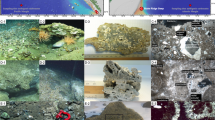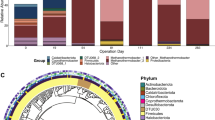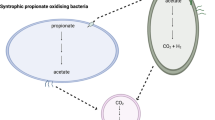Abstract
To identify the methanogenic pathways present in a deep aquifer associated with an accretionary prism in Southwest Japan, a series of geochemical and microbiological studies of natural gas and groundwater derived from a deep aquifer were performed. Stable carbon isotopic analysis of methane in the natural gas and dissolved inorganic carbon (mainly bicarbonate) in groundwater suggested that the methane was derived from both thermogenic and biogenic processes. Archaeal 16S rRNA gene analysis revealed the dominance of H2-using methanogens in the groundwater. Furthermore, the high potential of methane production by H2-using methanogens was shown in enrichments using groundwater amended with H2 and CO2. Bacterial 16S rRNA gene analysis showed that fermentative bacteria inhabited the deep aquifer. Anaerobic incubations using groundwater amended with organic substrates and bromoethanesulfonate (a methanogen inhibitor) suggested a high potential of H2 and CO2 generation by fermentative bacteria. To confirm whether or not methane is produced by a syntrophic consortium of H2-producing fermentative bacteria and H2-using methanogens, anaerobic incubations using the groundwater amended with organic substrates were performed. Consequently, H2 accumulation and rapid methane production were observed in these enrichments incubated at 55 and 65 °C. Thus, our results suggested that past and ongoing syntrophic biodegradation of organic compounds by H2-producing fermentative bacteria and H2-using methanogens, as well as a thermogenic reaction, contributes to the significant methane reserves in the deep aquifer associated with the accretionary prism in Southwest Japan.
Similar content being viewed by others
Log in or create a free account to read this content
Gain free access to this article, as well as selected content from this journal and more on nature.com
or
References
Aravena R, Harrison SM, Barker JF, Abercrombie H, Rudolph D . (2003). Origin of methane in the Elk Valley coalfield, southeastern British Columbia, Canada. Chem Geol 195: 219–227.
Balk M, Weijma J, Stams AJM . (2002). Thermotoga lettingae sp. nov., a novel thermophilic, methanol-degrading bacterium isolated from a thermophilic anaerobic reactor. Int J Syst Evol Microbiol 52: 1361–1368.
Bernard BB, Brooks JM, Sackett WM . (1978). Light hydrocarbons in recent Texas continental shelf and slope sediments. J Geophys Res 83: 4053–4061.
Carothers WW, Kharaka YK . (1980). Stable carbon isotopes of HCO3 in oil-field waters—implications for the origin of CO2 . Geochem Cosmochim Acta 44: 323–332.
Coenye T, Laevens S, Willems A, Ohlen M, Hannant W, Govan JRW et al. (2001). Burkholderia fungorum sp. nov. and Burkholderia caledonica sp. nov., two new species isolated from the environment, animals and human clinical samples. Int J Syst Evol Microbiol 51: 1099–1107.
Eder W, Ludwig W, Huber R . (1999). Novel 16S rRNA gene sequences retrieved from highly saline brine sediments of Kebrit Deep, Red Sea. Arch Microbiol 172: 213–218.
Good IJ . (1953). The population frequencies of species and the estimation of population parameters. Biometrika 40: 237–264.
Gray ND, Sherry A, Larter SR, Erdmann M, Leyris J, Liengen T et al. (2009). Biogenic methane production in formation waters from a large gas field in the North Sea. Extrimophiles 13: 511–519.
Großkopf R, Janssen PH, Liesack W . (1998). Diversity and structure of the methanogenic community in anoxic rice paddy soil microcosms as examined by cultivation and direct 16S rRNA gene sequence retrieval. Appl Environ Microbiol 64: 960–969.
Gunsalus RP, Romesser JA, Wolfe RS . (1978). Preparation of coenzyme M analogs and their activity in the methyl coenzyme M reductase system of Methanobacterium thermoautotrophicum. Biochemistry 17: 2374–2377.
Hattori S . (2008). Syntrophic acetate-oxidizing microbes in methanogenic environments. Microbes Environ 23: 118–127.
Henry EA, Devereux R, Maki JS, Gilmour CC, Woese CR, Mandelco L et al. (1994). Characterization of a new thermophilic sulfate-reducing bacterium Thermodesulfovibrio yellowstonii, gen. nov. and sp. nov.: its phylogenetic relationship to Thermodesulfobacterium commune and their origins deep within the bacterial domain. Arch Microbiol 161: 62–69.
Huber T, Faulkner G, Hugenholtz P . (2004). Bellerophon; a program to detect chimeric sequences in multiple sequence alignments. Bioinformatics 20: 2317–2319.
Igari S, Sakata S . (1989). Origin of natural gas of dissolved-in-water type in Japan inferred from chemical and isotopic compositions: occurrence of dissolved gas of thermogenic origin. Geochem J 23: 139–142.
Imachi H, Sekiguchi Y, Kamagata Y, Loy A, Qiu Y-L, Hugenholtz P et al. (2006). Non-sulfate-reducing, syntrophic bacteria affiliated with Desulfotomaculum cluster I are widely distributed in methanogenic environments. Appl Environ Microbiol 72: 2080–2091.
Jiang B, Henstra AM, Paulo PL, Balk M, van Doesburg W, Stams AJM . (2009). Atypical one-carbon metabolism of an acetogenic and hydrogenogenic Moorella thermoacetica strain. Arch Microbiol 191: 123–131.
Jolivet E, L’Haridon S, Corre E, Forterre P, Prieur D . (2003). Thermococcus gammatolerans sp. nov., a hyperthermophilic archaeon from a deep-sea hydrothermal vent that resists ionizing radiation. Int J Syst Evol Microbiol 53: 847–851.
Kano K, Nakaji M, Takeuchi S . (1991). Asymmetrical melange fabrics as possible indicators of the convergent direction of plates: a case study from the Shimanto Belt of the Akaishi Mountains, central Japan. Tectonophysics 185: 375–388.
Karasawa Y, Kano K . (1992). Formation and deformation process of the slate belt in the Setogawa Group (the Shimanto Belt) of the eastern Akaishi Mountains, easternmost Southwest Japan. J Geol Society Jpn 98: 761–777 (in Japanese with English abstract).
Kimura H, Sato M, Sugiyama C, Naganuma T . (2001). Coupling of thraustochytrids and POM, and of bacterio- and phytoplankton in a semi-enclosed coastal area: implication for different substrate preference by the planktonic decomposers. Aquat Microb Ecol 25: 293–300.
Kimura H, Sugihara M, Yamamoto H, Patel BKC, Kato K, Hanada S . (2005). Microbial community in a geothermal aquifer associated with the subsurface of the Great Artesian Basin, Australia. Extremophiles 9: 407–414.
Kimura H, Ishibashi J, Masuda H, Kato K, Hanada S . (2007). Selective phylogenetic analysis targeting 16S rRNA genes of hyperthermophilic archaea in the deep-subsurface hot biosphere. Appl Environ Microbiol 73: 2110–2117.
Millero FJ, Feistel R, Wright DG, McDougall TJ . (2008). The composition of standard seawater and the definition of the reference-composition salinity scale. Deep-Sea Res I 55: 50–72.
Miyajima T, Yamada Y, Hanba YT, Yoshii K, Koitabashi T, Wada E . (1995). Determining the stable isotope ratio of total dissolved inorganic carbon in lake water by GC/C/IRMS. Limnol Oceanogr 40: 994–1000.
Mochimaru H, Uchiyama H, Yoshioka H, Imachi H, Hoaki T, Tamaki H et al. (2007a). Methanogen diversity in deep subsurface gas-associated water at the Minami-kanto gas field in Japan. Geomicrobiol J 24: 93–100.
Mochimaru H, Yoshioka H, Tamaki H, Nakamura K, Kaneko N, Sakata S et al. (2007b). Microbial diversity and methanogenic potential in a high temperature natural gas field in Japan. Extremophiles 11: 453–461.
Nazina TN, Rozanova EP, Belyakova EV, Lysenko AM, Poltaraus AB, Tourova TP et al. (2005). Description of ‘Desulfotomaculum nigrificans subsp. Salinus’ as a New Species, Desulfotomaculum salinum sp. nov.. Mikrobiologiya 74: 654–662.
Ng TK, Weimer PJ, Zeikus JG . (1977). Cellulolytic and physiological properties of Clostridium thermocellum. Arch Microbiol 114: 1–7.
Pallasser RL . (2000). Recognising biodegradation in gas/oil accumulations through the δ13C compositions of gas components. Org Geochem 31: 1363–1373.
Pearson WR, Lipman DJ . (1988). Improved tools for biological sequence comparison. Proc Natl Acad Sci USA 85: 2444–2448.
Sakai S, Imachi H, Sekiguchi Y, Tseng I-C, Ohashi A, Harada H et al. (2009). Cultivation of methanogens under low-hydrogen conditions by using the coculture method. Appl Environ Microbiol 75: 4892–4896.
Schink B . (1997). Energetics of syntrophic cooperation in methanogenic degradation. Microbiol Mol Biol Rev 61: 262–280.
Schloss PD, Handelsman J . (2005). Introducing DOTUR, a computer program for defining operational taxonomic units and estimating species richness. Appl Environ Microbiol 71: 1501–1506.
Schöcke L, Schink B . (1998). Membrane-bound proton-translocating pyrophosphatase of Syntrophus gentianae, a syntrophically benzoate-degrading fermenting bacterium. Eur J Biochem 256: 589–594.
Schoell M . (1980). The hydrogen and carbon isotopic composition of methane from natural gases of various origins. Geochim Cosmochim Acta 44: 649–661.
Schoell M . (1983). Genetic characterization of natural gases. AAPG Bull 67: 2225–2238.
Shimizu S, Akiyama M, Naganuma T, Fujioka M, Nako M, Ishijima Y . (2007). Molecular characterization of microbial communities in deep coal seam groundwater of northern Japan. Geobiology 5: 423–433.
Shimoyama T, Kato S, Ishii S, Watanabe K . (2009). Flagellum mediates symbiosis. Science 323: 1574.
Shlimon AG, Friedrich MW, Niemann H, Ramsing NB, Finster K . (2004). Methanobacterium aarhusense sp. nov., a novel methanogen isolated from a marine sediment (Aarhus Bay, Denmark). Int J Syst Evol Microbiol 54: 759–763.
Smith JW, Pallasser RJ . (1996). Microbial origin of Australian coalbed methane. AAPG Bull 80: 891–897.
Stahl DA, Amann R . (1991). Development and application of nucleic acid probes in bacterial systematics. In: Stackebrandt E, Goodfellow M. (eds). Nucleic Acid Techniques in Bacterial Systematics. John Wiley and Sons: New York, pp 205–248.
Strąpoć D, Mastalerz M, Eble C, Schimmelmann A . (2007). Characterization of the origin of coalbed gases in southeastern Illinois Basin by compound-specific carbon and hydrogen stable isotope ratios. Org Geochem 38: 267–287.
Strąpoć D, Picardal FW, Turich C, Schaperdoth I, Macalady JL, Lipp JS et al. (2008). Methane-producing microbial community in a coal bed of the Illinois Basin. Appl Environ Microbiol 74: 2424–2432.
Taira A, Byrne T, Ashi J . (1992). Photographic Atlas of an Accretionary Prim. Tokyo University Press: Tokyo, Japan.
Taylor HP . (1974). The application of oxygen and hydrogen isotope studies to problems of hydrothermal alteration and ore deposition. Econ Geol 69: 843–883.
Wang Q, Garrity GM, Tiedje JM, Cole JR . (2007). Naïve Bayesian classifier for rapid assignment of rRNA sequences into the new bacterial taxonomy. Appl Environ Microbiol 73: 5261–5267.
Worakit S, Boone DR, Mah RA, Abdel-Samie ME, El-Halwagi MM . (1986). Methanobacterium alcaliphilum sp. nov., an H2-utilizing methanogen that grows at high pH values. Int J Syst Bacteriol 36: 380–382.
Yamada K, Ozaki Y, Nakagawa F, Tanaka M, Yoshida N . (2003). An improved method for measurement of the hydrogen isotope ratio of atmospheric methane and its application to a Japanese urban atmosphere. Atmos Environ 37: 1975–1982.
Yoshida N, Mizutani Y . (1986). Preparation of carbon dioxide for oxygen-18 determination of water by use of a plastic syringe. Anal Chem 58: 1273–1275.
Zeikus JG, Wolfe RS . (1972). Methanobacterium thermoautotrophicus sp. n., an anaerobic, autotrophic, extreme thermophile. J Bacteriol 109: 707–713.
Acknowledgements
We are grateful to Katsuya Yabuzaki and Masataka Saito (Shimada City Hall) for help with the natural gas and groundwater sampling. We thank Julia Maresca for comments on the manuscript. This work was supported by Grant-in-Aid for Young Scientist (B) (No. 18710007) and Scientific Research (A) (No.19201004) from the Ministry of Education, Culture, Sports, Science and Technology (MEXT), the Japan Atomic Energy Agency (JAEA) Cooperative Research Scheme on the Nuclear Fuel Cycle, and the Global Environment Research Fund (B-094) of the Ministry of the Environment, Japan.
Author information
Authors and Affiliations
Corresponding author
Additional information
Supplementary Information accompanies the paper on The ISME Journal website (http://www.nature.com/ismej)
Supplementary information
Rights and permissions
About this article
Cite this article
Kimura, H., Nashimoto, H., Shimizu, M. et al. Microbial methane production in deep aquifer associated with the accretionary prism in Southwest Japan. ISME J 4, 531–541 (2010). https://doi.org/10.1038/ismej.2009.132
Received:
Revised:
Accepted:
Published:
Issue date:
DOI: https://doi.org/10.1038/ismej.2009.132
Keywords
This article is cited by
-
Conceptualization of the recent change in groundwater quality of the shallow aquifer of the hydrocarbon-rich Barmer sedimentary basin, Rajasthan, India
Arabian Journal of Geosciences (2023)
-
Thermophilic endospores associated with migrated thermogenic hydrocarbons in deep Gulf of Mexico marine sediments
The ISME Journal (2018)
-
Potential of biogenic methane for pilot-scale fermentation ex situ with lump anthracite and the changes of methanogenic consortia
Journal of Industrial Microbiology and Biotechnology (2018)
-
Hydrogen and carbon isotope systematics in hydrogenotrophic methanogenesis under H2-limited and H2-enriched conditions: implications for the origin of methane and its isotopic diagnosis
Progress in Earth and Planetary Science (2016)
-
Metabolic stratification driven by surface and subsurface interactions in a terrestrial mud volcano
The ISME Journal (2012)



